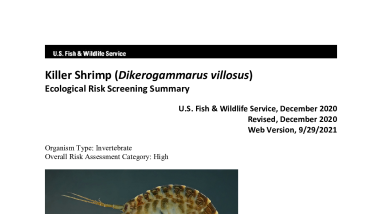Species that are considered high risk have a well-documented history of invasiveness in at least one location globally, and a high or medium climate match to the contiguous United States.
The Killer Shrimp (Dikerogammarus villosus) is a small freshwater and brackish amphipod native to the Ponto-Caspian basin of Europe. The species can tolerate a wide range of environments, and can breed year-round if water temperatures are warm enough. Dikerogammarus villosus is listed as prohibited by State agencies in Michigan (Michigan Invasive Species 2020) and Wisconsin (Wisconsin Department of Natural Resources 2013). The history of invasiveness is classified as High. D. villosus has spread to new waterways through accidental shipping transport and natural dispersion through canal systems. Zebra mussels (Dreissena polymorpha) may facilitate its establishment by creating particularly favorable conditions. Peer-reviewed literature has demonstrated the species has a negative impact on zooplankton and macroinvertebrate communities in newly established areas. Experimental studies demonstrate the species may adversely affect native fish populations and water quality once established in new areas. The overall climate match was High, particularly around the Great Lakes where established zebra mussels could aid D. villosus spread. The certainty of assessment is High. The overall risk assessment category is High.


